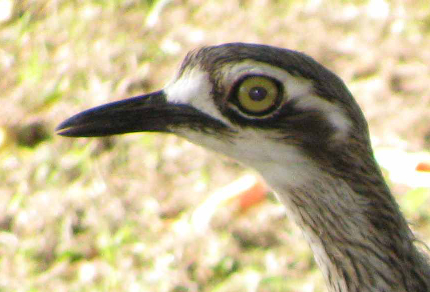
Bush Stone-curlew (© Magi Nams)
In the Townsvillian nights, haunting wails frequently tear the darkness, causing my vivid imagination to envision ghostly figures demented by losses too great to bear crying out to the world in distress. The wailing cries are, in fact, the calls of the bush stone-curlew, a leggy wader also known as the bush thick-knee or, more onomatopoeiatically, as the weeloo or willaroo.1 Occasionally, the weeloos emit their evocative vocalizations during daylight hours, which allowed me to connect the sound with its source.
I often see bush stone-curlews on the Townsville Golf Course and have spotted them in city parks, at James Cook University, and at the Townsville Town Common Conservation Park located between the suburbs of Rowe’s Bay and Pallarenda. During the day, they rest like lumps on long sticks in the shade under trees, or if awake, skulk from shelter to shelter with long strides and neck thrust forward. Some fold their legs beneath them to rest on the ground, with the occasional bird stretching its long neck along the ground surface, perhaps as a camouflage maneuver. I’ve observed birds with closed or half-closed eyes, obviously dozing after a night of wailing and who knows what.
I chose to write this post because it occurred to me that I know next to nothing about this diurnally shy, but nocturnally vociferous bird I’ve seen nearly every time I cycle or walk past the nearby golf club. So, I did a little reading.
Bush stone-curlews are one of two Australian species of the avian family Burhinidae, a group of large waders with big, yellow eyes and plumages that combine the colours white, brown, grey, and black in streaked or blocked patterns.2 The other Aussie species is the beach stone-curlew, which I’ve not yet seen, although I’ve looked for it. Neither of these stone-curlews is endemic to Australia, with both occuring in Papua New Guinea, and the beach stone-curlew in Malaysia, the Phillipines region, and New Caledonia.1

Bush Stone-curlew (© Magi Nams)
The bush stone-curlew is an unusual ‘wader’ in that it frequents the bush rather than the beach, as its name suggests. In addition to making itself at home in city parks, it can be found in open woodlands and other open, ‘untidy’ habitats with some shrub or tree growth and fallen branches, grasses, or leaf litter. 1,3 Geographically, it occurs in a wide band around the top of Australia and along the east coast, as well as on the continent’s west coast,1 but the species is endangered in New South Wales and Victoria, and vulnerable in South Australia.3
Bush stone-curlews are predatory birds that hunt insects and other arthropods, as well as molluscs, small reptiles, amphibians, and mammals.2 In times of drought, they also eat seeds and tubers.4 They use their beaks to probe foods from rotting wood or soil, and forage over large home ranges.4 This, they do under the cover of darkness (particularly on moonlit nights),1,4 which suits their secretive nature. Although their streaked plumage offers them the advantage of camouflage protection against visual predators, it’s ineffective against olfactory predators like foxes, dingoes, and goannas (monitor lizards), which hunt them by smell. 4
Weeloos breed during spring and summer, with the females laying a pair of blotchy, stone-coloured eggs on the bare ground,1 often beside fallen branches.3 Nesting success of bush stone-curlews is threatened by cattle that stomp on eggs, and by foxes that eat eggs, as well as by land clearing and the tidying up of woodland debris.3 Now, when I stroll past the golf club and see bush stone-curlews, I’ll be looking for their eggs, too.
References:
1. Graham Pizzey and Frank Knight. The Field Guide to the Birds of Australia. 1997. Angus & Robertson, Sydney, p. 158; 2. Ibid, p. 530.
3. Australian Government & WWF-Australia, Threatened Species Network. Australian Threatened Species: Bush stone-curlew Burhinus grallarius. Accessed 22-Sep-2010. http://www.environment.gov.au/biodiversity/threatened/publications/pubs/tsd05bush-stone-curlew.pdf
4. Wikipedia. Bush Stone-curlew. Updated 10-Mar-2010. Accessed 22-Sep-2010. http://en.wikipedia.org/wiki/Bush_Stone-curlew


